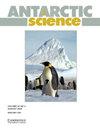Impact of the harsh Antarctic environment on mucosal immunity
IF 2
4区 地球科学
Q3 ENVIRONMENTAL SCIENCES
引用次数: 1
Abstract
Abstract Mucosal immunity of Indian Antarctic personnel was analysed during the 34th Indian Scientific Expedition to Antarctica (ISEA) by ship voyage. Serum and salivary IgA, IgA1 and IgA2 levels along with salivary cortisol and TGF-β were quantified by enzyme-linked immunosorbent assay. Samples were collected at three different time points (T1, T2 and T3) during the expedition. Serum and salivary IgA, IgA1 and IgA2 concentrations incrementally increased towards the end of the expedition as compared to the beginning of the expedition. Salivary IgA and TGF-β levels were significantly altered during the expedition. Levels of IgA1 (P = 0.0007) and IgA2 (P = 0.0135) increased significantly at T3 as compared to T1. Additionally, significant changes in serum IgA were observed, with peak levels at T3 (P = 0.0015) and T2 (P < 0.001). However, the level of serum IgA2 was also significantly altered at T3 (P < 0.05) and T2 (P = 0.0006) in comparison with T1. The exact cause of the changes in serum and salivary IgA, IgA1, IgA2 and TGF-β levels during the summer expedition are unknown; however, the changes are evident in mucosal immunity.南极恶劣环境对黏膜免疫的影响
摘要在第34次印度南极科学考察(ISEA)期间,对印度南极人员的粘膜免疫进行了分析。血清和唾液IgA、IgA1和IgA2水平以及唾液皮质醇和TGF-β通过酶联免疫吸附测定进行定量。在探险期间,在三个不同的时间点(T1、T2和T3)采集了样本。与探险开始时相比,探险结束时血清和唾液IgA、IgA1和IgA2浓度逐渐增加。唾液IgA和TGF-β水平在探险过程中发生了显著变化。与T1相比,T3时IgA1(P=0.0007)和IgA2(P=0.0135)的水平显著增加。此外,观察到血清IgA的显著变化,在T3(P=0.0015)和T2(P<0.001)达到峰值。然而,与T1相比,血清IgA2的水平在T3(P<0.05)和T2也发生了显著变化。夏季探险期间血清和唾液IgA、IgA1、IgA2和TGF-β水平变化的确切原因尚不清楚;然而,这种变化在粘膜免疫中是明显的。
本文章由计算机程序翻译,如有差异,请以英文原文为准。
求助全文
约1分钟内获得全文
求助全文
来源期刊

Antarctic Science
地学-地球科学综合
CiteScore
3.60
自引率
6.20%
发文量
42
审稿时长
3 months
期刊介绍:
Antarctic Science provides a truly international forum for the broad spread of studies that increasingly characterise scientific research in the Antarctic. Whilst emphasising interdisciplinary work, the journal publishes papers from environmental management to biodiversity, from volcanoes to icebergs, and from oceanography to the upper atmosphere. No other journal covers such a wide range of Antarctic scientific studies. The journal attracts papers from all countries currently undertaking Antarctic research. It publishes both review and data papers with no limits on length, two-page short notes on technical developments and recent discoveries, and book reviews. These, together with an editorial discussing broader aspects of science, provide a rich and varied mixture of items to interest researchers in all areas of science. There are no page charges, or charges for colour, to authors publishing in the Journal. One issue each year is normally devoted to a specific theme or papers from a major meeting.
 求助内容:
求助内容: 应助结果提醒方式:
应助结果提醒方式:


